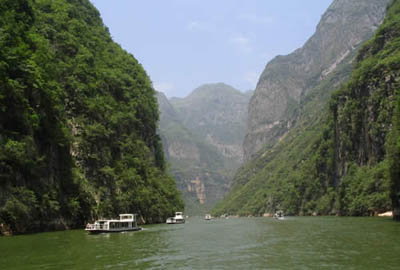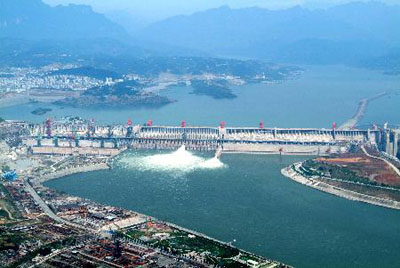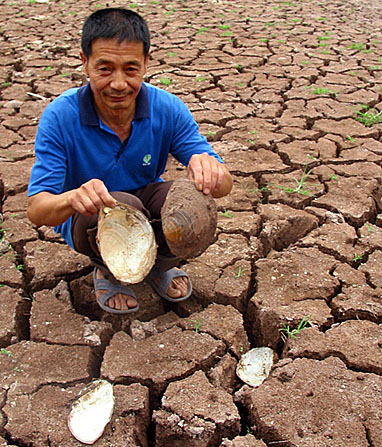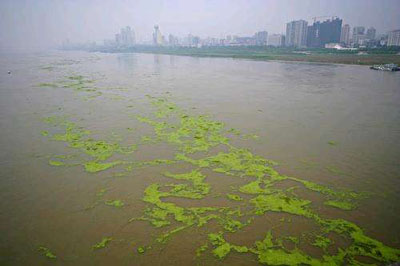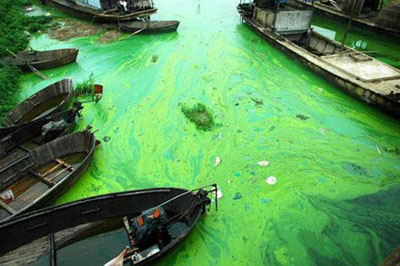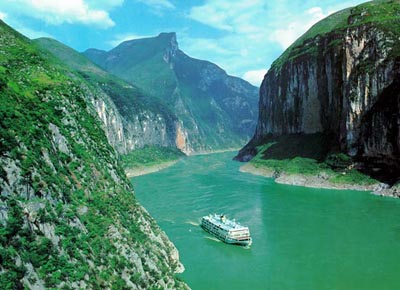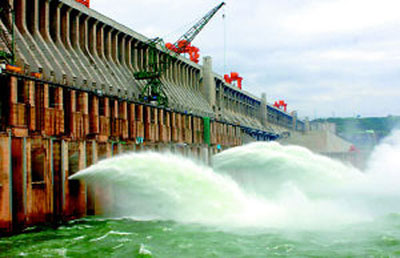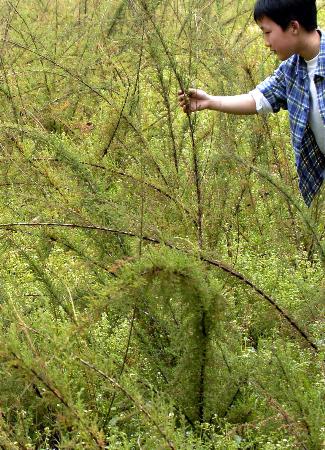The government is facing up to the hidden environmental threats stemming from construction of the 180 billion yuan (US$24 billion) Three Gorges Project, experts and officials said at a workshop yesterday.
Environmental damage caused by the largest hydroelectric river dam project in the world needed to be addressed to avert a disaster, participants said at the two-day forum debating the project, in Wuhan, capital of Hubei Province.
On the plus side the dam will prevent seasonal flooding on the lower reaches of the Yangtze River and electricity generated by hydropower will reduce carbon emissions, but the benefits will have an environmental cost, they said.
Forum members said the project had "adversely" affected the Three Gorges reservoir environment.
Problems mentioned included disruption of the ecosystem, more frequent natural disasters, severe erosion and landslides, land shortages and ecological degradation.More...
Experts Analyze Causes of Rat Scourge
The gigantic Three Gorges Dam project and global warming could be to blame for the recent rodent outbreak in central China's Hunan Province.
The rodent scourge surrounding Dongting Lake, China's second-largest freshwater lake, had been for the most part controlled. In a recent two-week mouse offensive, residents of the 22 counties encircling the lake eradicated some 2.3 million of the estimated 2 billion rodents.
The rodents were driven out into populated areas when floodwaters burst out in late June.
Shi Dazhao, director of the Chinese Agricultural University's laboratory on the prevention and control of rodents, and a consultant to the Chinese Association for the Control of Rodents and Sanitary Insects (CPCA), attributed the magnitude of this year's rat pest problem to the gigantic dam project and global warming. More...
Report Shows Yangtze Water Environment Deteriorating
The first annual health report on the Yangtze River indicates that the billions of tons of waste that continue to be dumped into China's longest waterway are taking a serious toll its aquatic life.
The 2007 annual report on Yangtze River protection and development shows that more than 600 kilometers of the river are in critical condition. The report says almost 30 percent of its major tributaries, including the Minjiang, Tuojiang, Xiangjiang, and Huangpu rivers, are seriously polluted.
The report says the river's annual harvest of aquatic products dropped from 427,000 tons in the 1950s to about 100,000 tons in the 1990s.
A separate study by the Yangtze River Water Resources Commission shows cities along the river discharge at least 14.2 billion tons of polluted water every year, 42 percent of China's total. More...
Plight of Yangtze River Worsened by Water Shortage
Reefs exposed, ships stranded and fish stocks plummeting, the continuing ordeal of China's Yangtze River has been exacerbated by the worst water shortage in more than a century.
Heat waves hit Chongqing Municipality and Sichuan Province in the upper Yangtze last summer, and rainfall was nearly halved in most sections of the Yangtze, resulting in a severe drought.
Water in the upper reaches decreased by over 60 percent from the previous year, and cities downstream reported the lowest water levels since records were first kept in 1877.
"Previously we had to prepare for floods, but the drought has changed all that," said Zhou Jinyun, director of the fishery bureau in the port city of Anqing, in east China's Anhui Province, in the middle reaches of the river.
In Anqing, the water is only four meters deep, and will continue to drop as the drought continues, Zhou said. More...
Nitrogen, Phosphorus Threat to Yangtze
Excessive nitrogen and phosphorus are the major water pollutants in the Three Gorges Dam area, the 2007 Yangtze Conservation and Development Report has said.
The report on the Three Gorges Dam, the largest hydro-power plant in the world, was released at the second Yangtze Forum held in Changsha, capital of central China's Hunan Province, over the weekend.
"Nitrogen and phosphorus, which come mainly from domestic disposals and fertilizers, account for 60-70 percent of the pollutants in the Three Gorges Dam area," said Weng Lida, of the Yangtze River Water Resources Protection Bureau under the Ministry of Water Resources.
"Such pollution from non-point sources is very hard to control," Weng said. "If the pollutants had been discharged by a few plants, they could have been moved out of the area. But nitrogen and phosphorus are used by millions of people living there, hence, it is difficult to ask them to stop using substances containing the pollutants." More...
Official Warns of Major Algae Outbreak
The top environmental official has called for improved measures to protect the country's lakes, warning that a major outbreak of blue-green algae may hit the nation's three major water systems.
Addressing a meeting of environmental officials in Hefei, east China's Anhui Province, on Thursday, State Environment Protection Administration (SEPA) Minister Zhou Shengxian said that Caohu Lake, Dianchi Lake and the tributaries near the Three Gorges Dam on the Yangtze River, the country's longest, may be hit.
Zhou said high concentrations of nitrogen and phosphorus in the water, which foster outbreaks of algae, remain a major problem for the country's natural lakes, which are disappearing at a rate of 20 a year.
SEPA has imposed a number of bans in areas near the Taihu, Chaohu and Dianchi lakes.
All projects involving discharges containing ammonia and phosphorus were prohibited in those areas, while the production, use and sale of detergents containing phosphorous was also banned around the lake drainage areas. More...
Neither Droughts Nor Floods Caused by Three Gorges Project
Droughts and floods in southwest China's Sichuan Province have not been caused by the Three Gorges Project but by climate change, an expert said on Monday.
Jiao Meiyan, director of the National Meteorological Center, said Sichuan Province and Chongqing Municipality were hit by severe drought in 2006 but both areas have suffered relentless rainstorms this summer.
"The contrasting weather has convinced us that the rumor saying the Three Gorges Project, in particular the dam, had obstructed water vapor from entering Sichuan and Chongqing was not justified," he said.
Since mid-July, Sichuan and Chongqing have been pounded by heavy rainstorms that could only happen once in a hundred years, leading to a huge number of casualties. By July 20, more than six million citizens were affected by the continuous rainfall in Chongqing. More...
Three Gorges Dam Has Minimal Impact on Environment: Official
The environment in the Three Gorges Dam area has been stable since the water level reached 156 meters fours month ago, said Wang Xiaofeng, deputy director of the Three Gorges Project Construction Committee.
The environment in the Three Gorges Dam area has been stable since the water level reached 156 meters fours month ago, a chief project planner said.
"Thanks to efforts to curb water pollution, soil erosion and geological disasters, the water quality in the gorges has maintained its drinking standard since the Three Gorges Dam began storing water in 2003," said Wang Xiaofeng, deputy director of the Three Gorges Project Construction Committee.
The government has plans to spend nearly 40 billion yuan (US$5 billion) between 2001 and 2010 to build at least 150 sewage treatment plants and 170 urban garbage disposal centers to prevent water pollution in the Three Gorges Dam and the upper reaches of the Yangtze River. More...
Scientific Investigation Launched to Protect Plants in Three Gorges
China on Saturday launched a large-scale scientific investigation into plants in Three Gorges, which would collect 28,000 specimens in three years.
A team of nine scientists from the Chinese Academy of Sciences (CAS) arrived here on Saturday as the first batch of more than 60 scientists who are expected to join the investigation.
"The investigation is the largest of its kind in Three Gorges, and would provide reliable reference for the protection of plants and the ecological environment," said Li Liangqian, chief researcher of the CAS Institute of Botany.
New plant communities are expected to be found during the investigation, which would enrich the botanical resources of China and boost the development of medical and gene sciences, according to Li.
The scientists conducted the scientific investigation under the request of the Office of the Three Gorges Project Construction Committee of the State Council in April. More...
(China.org.cn September 28, 2007)

